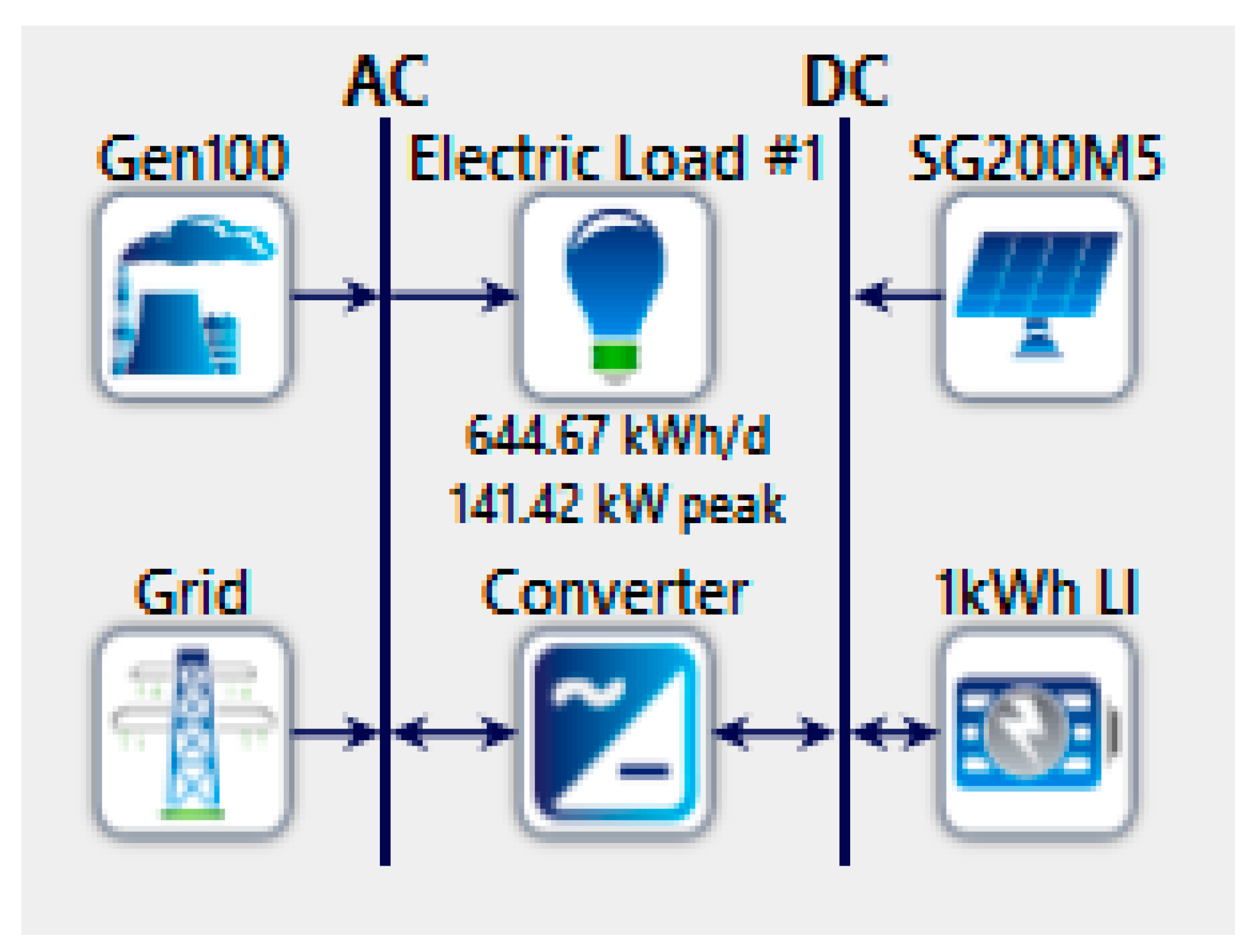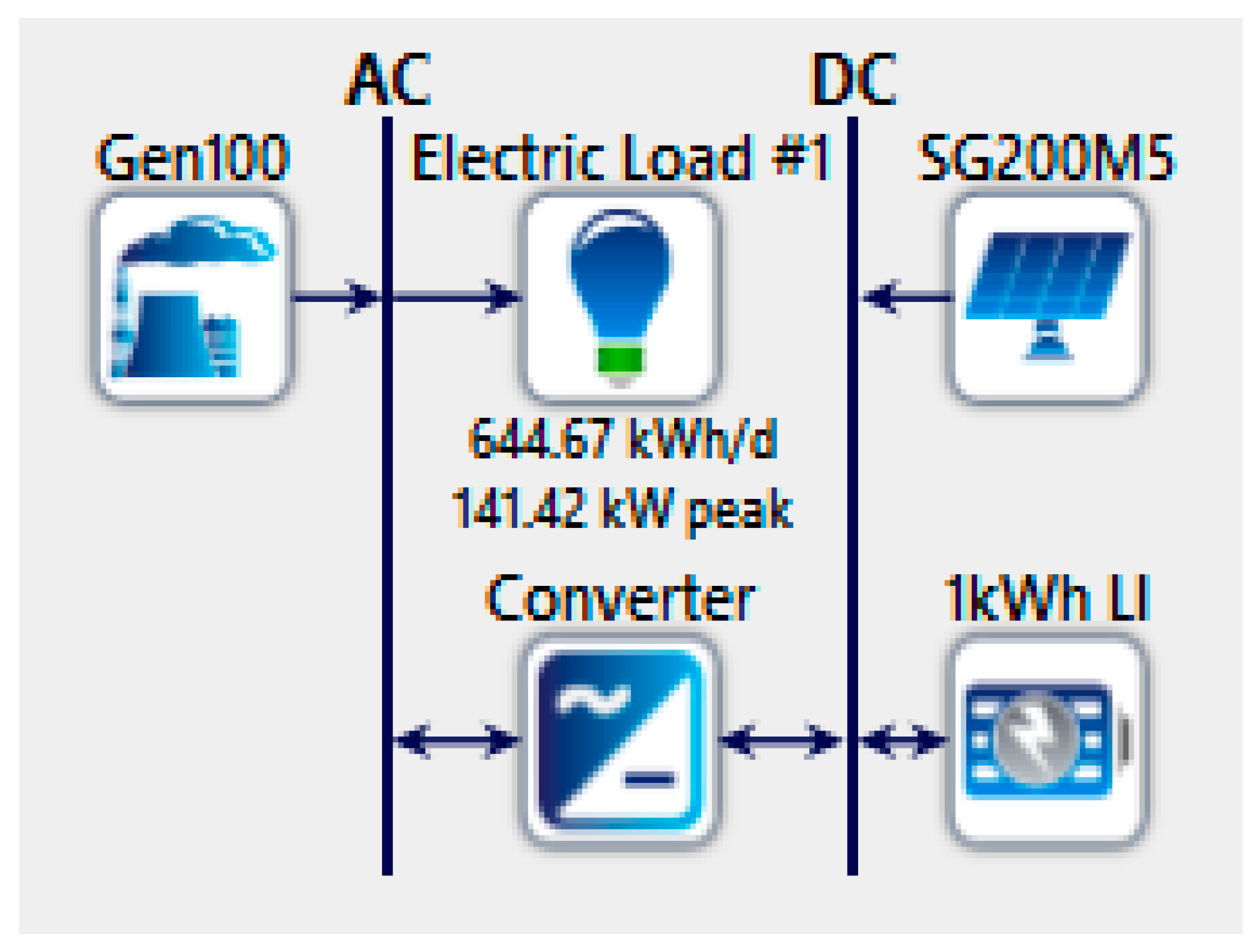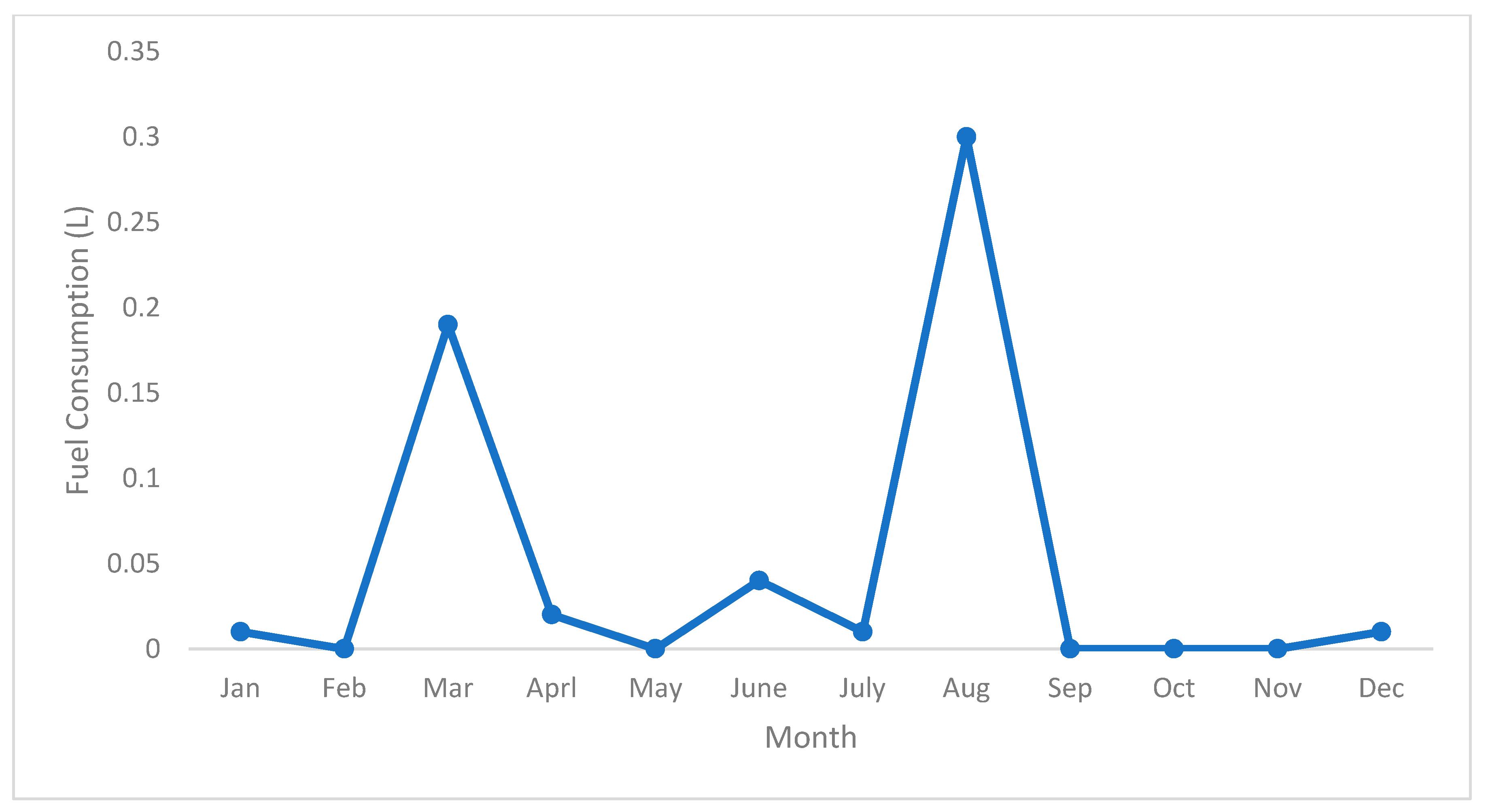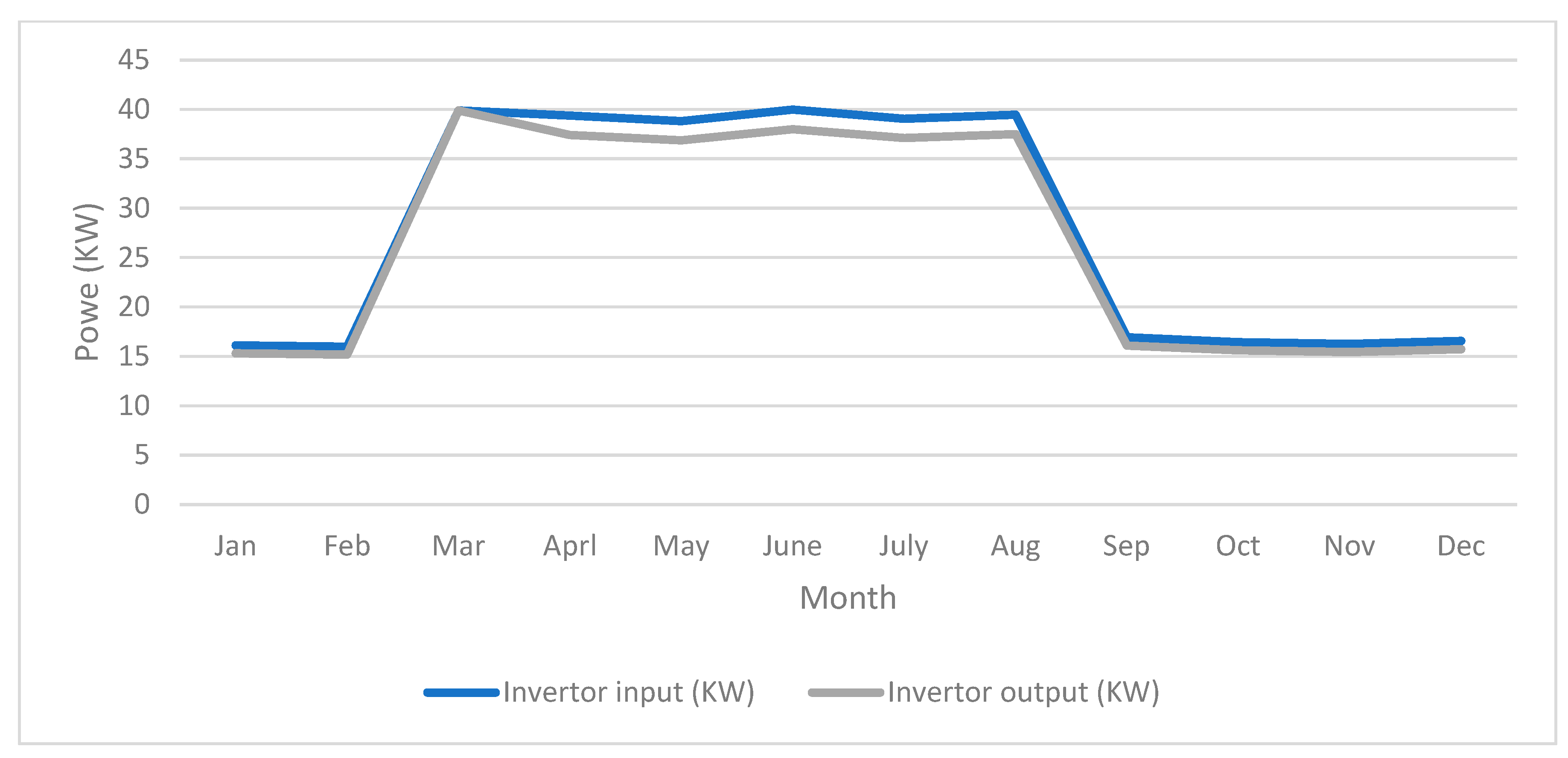Economic Integration of Renewable and Conventional Power Sources—A Case Study
Abstract
:1. Introduction
- A framework for hybrid microgrid optimization was suggested by considering the key features of the sustainable development goals (inexpensive, reliable, and sustainable).
- Under each feature of sustainable development goals, few benchmarks were spotted, i.e., inexpensive: lower COE, NPV, and capital investments; reliable: continuous power supply, minimized energy shortage, and ensured the quality of power; and sustainable: higher renewable fraction and minimum emissions.
- Modeling of the hybrid renewable energy microgrid considering PV/DG/Battery backup was designed and analyzed for a Mirpur University of Pakistan by considering the weather conditions.
Introduction to HOMER-Pro
2. Methodology
2.1. Site Selection
2.2. Installed Load and Metrological Data Calculations
2.3. Energy Resources
2.4. Software
3. Design of Microgrid
3.1. Grid Power
3.2. Solar Photovoltaic System
3.3. Battery Bank
3.4. Diesel Generator
3.5. Power Convertor
3.6. Load
4. Assessment Criteria for Optimization
4.1. Net Present Cost (NPC)
4.2. Levelized Cost of Energy (COE)
4.3. Operating Cost (OC)
4.4. Capital Cost (CC)
4.5. Renewable Fraction
5. Optimization of Microgrid
6. Discussion
7. Conclusions
Author Contributions
Funding
Institutional Review Board Statement
Informed Consent Statement
Data Availability Statement
Conflicts of Interest
References
- Dialga, I. Evaluating Normandy’s sustainable development and energy transition policies. J. Clean. Prod. 2021, 305, 127096. [Google Scholar] [CrossRef]
- Tiranzoni, P.; Sapio, A.; Casamassima, A.; Falcone, P.M. Assessing energy misperception in Europe: Evidence from the European social survey. Energy Sources Part B Econ. Plan. Policy 2022, 1–16. [Google Scholar] [CrossRef]
- United Nations. Paris Agreement, United Nations Framework Convention on Climate Change; United Nations: New York, NY, USA, 2015. [Google Scholar]
- Mendonça, S.; Lacey, F. Hvelplund, Stability, participation and transparency in renewable energy policy: Lessons from Denmark and the United States. Policy Soc. 2009, 27, 379–398. [Google Scholar] [CrossRef] [Green Version]
- Falcone, P.M.; Imbert, E.; Sica, E.; Morone, P. Towards a bioenergy transition in Italy? Exploring regional stakeholder perspectives towards the Gela and Porto Marghera biorefineries. Energy Res. Soc. Sci. 2021, 80, 102238. [Google Scholar] [CrossRef]
- Truffer, B.; Coenen, L. Environmental innovation and sustainability transitions in regional studies. Reg. Stud. 2021, 46, 1–21. [Google Scholar] [CrossRef]
- Sorman, A.H.; García-Muros, X.; Pizarro-Irizar, C.; González-Eguino, M. Lost (and found) in Transition: Expert stakeholder insights on low-carbon energy transitions in Spain. Energy Res. Soc. Sci. 2020, 64, 101414. [Google Scholar] [CrossRef]
- Boyle, E.; Watson, C.; Mullally, G.; Gallachóir, B.Ó. Regime-based transition intermediaries at the grassroots for community energy initiatives. Energy Res. Soc. Sci. 2021, 74, 101950. [Google Scholar] [CrossRef]
- Boudoudouh, S.; Maâroufi, M. Multi agent system solution to microgrid implementation. Sustain. Cities Soc. 2018, 39, 252–261. [Google Scholar] [CrossRef]
- Khorasany, M.; Azuatalam, D.; Glasgow, R.; Liebman, A.; Razzaghi, R. Transactive energy market for energy management in microgrids: The monash microgrid case study. Energies 2020, 13, 2010. [Google Scholar] [CrossRef]
- Dash, R.L.; Behera, L.; Mohanty, B.; Hota, P.K. Cost and sensitivity analysis of a microgrid using HOMER-Pro software in both grid connected and standalone mode. In Proceedings of the 2018 International Conference on Recent Innovations in Electrical, Electronics & Communication Engineering (ICRIEECE), Bhubaneswar, India, 27–28 July 2018; pp. 3444–3449. [Google Scholar]
- Lopolito, A.; Falcone, P.M.; Sica, E. The role of proximity in sustainability transitions: A technological niche evolution analysis. Res. Policy 2022, 51, 104464. [Google Scholar] [CrossRef]
- D’Adamo, I.; Falcone, P.M.; Imbert, E.; Morone, P. Exploring regional transitions to the bioeconomy using a socio-economic indicator: The case of Italy. Econ. Polit. 2020, 1–33. [Google Scholar] [CrossRef]
- Shafiullah, G.M.; Amanullah, M.T.O.; Ali, A.S.; Jarvis, D.; Wolfs, P. Prospects of renewable energy—A feasibility study in the Australian context. Renew. Energy 2012, 39, 183–197. [Google Scholar] [CrossRef]
- Shoeb, M.; Shafiullah, G.M. Renewable energy integrated islanded microgrid for sustainable irrigation—A Bangladesh perspective. Energies 2018, 11, 1283. [Google Scholar] [CrossRef] [Green Version]
- Höfer, T.; Madlener, R. A participatory stakeholder process for evaluating sustainable energy transition scenarios. Energy Policy 2020, 139, 111277. [Google Scholar] [CrossRef] [Green Version]
- Ali, I.; Shafiullah, G.M.; Urmee, T. A preliminary feasibility of roof-mounted solar PV systems in the Maldives. Renew. Sustain. Energy Rev. 2018, 18, 18–32. [Google Scholar] [CrossRef]
- Brka, A.; Al-Abdeli, Y.M.; Kothapalli, G. The interplay between renewables penetration, costing and emissions in the sizing of stand-alone hydrogen systems. Int. J. Hydrogen Energy 2015, 40, 125–135. [Google Scholar] [CrossRef]
- Baek, S.; Park, E.; Kim, M.G.; Kwon, S.J.; Kim, K.J.; Ohm, J.Y.; del Pobil, A.P. Optimal renewable power generation systems for Busan metropolitan city in South Korea. Renew. Energy 2016, 88, 517–525. [Google Scholar] [CrossRef]
- Panayiotou, G.; Kalogirou, S.; Tassou, S. Design and simulation of a PV and a PVWind standalone energy system to power a household application. Renew. Energy 2012, 37, 355–363. [Google Scholar] [CrossRef]
- Gangwar, S.; Bhanja, D.; Biswas, A. Cost, reliability, and sensitivity of a stand-alone hybrid renewable energy system—A case study on a lecture building with low load factor. J. Renew. Sustain. Energy 2015, 7, 013109. [Google Scholar] [CrossRef]
- Islam, A.K.M.S.; Rahman, M.M.; Mondal, M.A.H.; Alam, F. Hybrid energy system for St. Martin Island, Bangladesh: An optimized model. Procedia Eng. 2012, 49, 179–188. [Google Scholar] [CrossRef] [Green Version]
- Ahmad, J.; Imran, M.; Khalid, A.; Iqbal, W.; Ashraf, S.R.; Adnan, M.; Ali, S.F.; Khokhar, K.S. Techno economic analysis of a wind-photovoltaic-biomass hybrid renewable energy system for rural electrification: A case study of Kallar Kahar. Energy 2018, 148, 208–234. [Google Scholar] [CrossRef]
- Baghdadi, F.; Mohammedi, K.; Diaf, S.; Behar, O. Feasibility study and energy conversion analysis of stand-alone hybrid renewable energy system. Energy Convers. Manag. 2015, 105, 471–479. [Google Scholar] [CrossRef]
- Enevoldsen, P.; Sovacool, B.K. Integrating power systems for remote island energy supply: Lessons from Mykines, Faroe Islands. Renew. Energy 2016, 85, 642–648. [Google Scholar] [CrossRef]
- Sharafi, M.; ELMekkawy, T.Y. Multi-objective optimal design of hybrid renewable energy systems using PSO-simulation based approach. Renew. Energy 2014, 68, 67–79. [Google Scholar] [CrossRef]
- Biswas, A.; Kumar, A. Techno-economic optimization of a stand-alone PV/PHS/ Battery systems for very low load situation. Int. J. Renew. Energy Res. 2017, 7, 844–856. [Google Scholar]
- Fazelpour, F.; Soltani, N.; Rosen, M.A. Feasibility of satisfying electrical energy needs with hybrid systems for a medium-size hotel on Kish Island, Iran. Energy 2014, 73, 856–865. [Google Scholar] [CrossRef]
- Bhattacharjee, S.; Acharya, S. PV–wind hybrid power option for a low wind topography. Energy Convers. Manag. 2015, 89, 942–954. [Google Scholar] [CrossRef]
- Türkay, B.E.; Telli, A.Y. Economic analysis of standalone and grid connected hybrid energy systems. Renew. Energy 2011, 36, 1931–1943. [Google Scholar] [CrossRef]
- Thakur, G.; Sharma, K.K.; Kaur, I.; Singh, B. Cost Analysis of Hybrid Power System Design Using Homer; Springer: Singapore, 2018; pp. 247–257. [Google Scholar]
- Nafeh, A.E. Optimal economical sizing of a PV-wind hybrid energy system using genetic algorithm. Int. J. Green Energy 2011, 8, 25–43. [Google Scholar] [CrossRef]
- Li, B.; Roche, R.; Miraoui, A. Microgrid sizing with combined evolutionary algorithm and MILP unit commitment. Appl. Energy 2017, 188, 547–562. [Google Scholar] [CrossRef] [Green Version]
- Abdelhamid, K.; Rachid, I. Techno-economic optimization of hybrid photovoltaic/wind/diesel/battery generation in a stand-alone power system. Sol. Energy 2014, 103, 171–182. [Google Scholar]
- Heydari, A.; Askarzadeh, A. Optimization of a biomass-based photovoltaic power plant for an off-grid application subject to loss of power supply probability concept. Appl. Energy 2016, 165, 601–611. [Google Scholar] [CrossRef]
- Spyrou, I.D.; Anagnostopoulos, J.S. Design study of a stand-alone desalination system powered by renewable energy sources and a pumped storage unit. Desalination 2010, 257, 137–149. [Google Scholar] [CrossRef]
- Rousis, A.O.; Tzelepis, D.; Konstantelos, I.; Booth, C.; Strbac, G. Design of a Hybrid AC/DC Microgrid Using HOMER Pro: Case Study on an Islanded Residential Application. Inventions 2018, 3, 55. [Google Scholar] [CrossRef] [Green Version]
- Çetinbaş, İ.; Tamyürek, B.; Demirtaş, M. Design and analysis of a hybrid microgrid system using HOMER software: Eskisehir Osmangazi University example. Int. J. Renew. Energy Dev. 2019, 8, 65. [Google Scholar] [CrossRef] [Green Version]
- Garni, H.Z.A.; Awasthi, A.; Ramli, M.A.M. Optimal design and analysis of grid-connected photovoltaic under different tracking systems using HOMER. Energy Convers. Manag. 2018, 155, 42–57. [Google Scholar] [CrossRef]
- Halabi, L.M.; Mekhilef, S.; Olatomiwa, L.; Hazelton, J. Performance analysis of hybrid PV/diesel/battery system using HOMER: A case study Sabah, Malaysia. Energy Convers. Manag. 2017, 144, 322–339. [Google Scholar] [CrossRef]
- Hirsch, A.; Parag, Y.; Guerrero, J. Microgrids: A review of technologies, key drivers, and outstanding issues. Renew. Sustain. Energy Rev. 2018, 90, 402–411. [Google Scholar] [CrossRef]
- HOMER Pro 3.12. Available online: https://www.homerenergy.com/products/pro/docs/3.12/index.Html (accessed on 27 January 2022).
- Jatoi, A.R.; Samo, S.R.; Jakhrani, A.Q. Influence of Temperature on Electrical Characteristics of Different Photovoltaic Module Technologies. Int. J. Renew. Energy Dev. 2018, 7, 85–91. [Google Scholar] [CrossRef]
- Jinko Solar. Available online: https://www.jinkosolar.com/ftp/EN-Eagle+-275PP(Plus)-60_rev2015.pdf (accessed on 27 January 2022).
- Jordan, D.C.; Kurtz, S.R.; VanSant, K.; Newmiller, J. Compendium of photovoltaic degradation rates. Prog. Photovolt. Res. Appl. 2016, 24, 978–989. [Google Scholar] [CrossRef]
- Awan, M.M.A.; Awan, F.G. Improvement of maximum power point tracking perturb and observe algorithm for a standalone solar photovoltaic system. Mehran Univ. Res. J. Eng. Technol. 2017, 36, 501–510. [Google Scholar] [CrossRef] [Green Version]
- Afzal Awan, M.M.; Mahmood, T. A novel ten check maximum power point tracking algorithm for a standalone solar photovoltaic system. Electronics 2018, 7, 327. [Google Scholar] [CrossRef] [Green Version]
- Awan, M.M.A.; Mahmood, T. Optimization of maximum power point tracking flower pollination algorithm for a standalone solar photovoltaic system. Mehran Univ. Res. J. Eng. Technol. 2020, 39, 267–278. [Google Scholar] [CrossRef]
- Nasab, N.M.; Kilby, J.; Bakhtiaryfard, L. Case study of a hybrid wind and tidal turbines system with a microgrid for power supply to a remote off-grid community in New Zealand. Energies 2021, 14, 3638. [Google Scholar]
- Optimize the Value of Your Hybrid Power System—From Utility-Scale and Distributed Generation to Standalone Microgrids. Available online: https://www.homerenergy.com (accessed on 27 January 2022).













| Ground Floor | ||||
| Sr. No | D.B Light Load | QTY | Load | Total Load |
| 01 | Fluorescent light with 01 tube | 60 | 36 | 2160 |
| 02 | Fluorescent light with 02 tube | 220 | 72 | 15,840 |
| 03 | Ceiling light | 225 | 20 | 4500 |
| 04 | Ceiling fan | 170 | 100 | 17,000 |
| 05 | Wardrobe bracket fan | 25 | 100 | 2500 |
| 06 | Exhaust fan | 20 | 100 | 2000 |
| 07 | Light plug 5A | 50 | 150 | 7500 |
| First Floor | ||||
| 01 | Fluorescent light with 01 tube | 25 | 36 | 900 |
| 02 | Fluorescent light with 02 tube | 160 | 72 | 11,520 |
| 03 | Ceiling light | 120 | 20 | 2400 |
| 04 | Ceiling fan | 120 | 100 | 12,000 |
| 06 | Exhaust fan | 10 | 100 | 1000 |
| 07 | Light plug 5A | 20 | 150 | 3000 |
| Total Load of Civil and Mechanical Department | 82,320 [W] | |||
| Components of Microgrid | Parameters | Unit Cost | Unit |
|---|---|---|---|
| Grid | Purchase Price | 0.22 | $/kWh |
| Sellback Price | 0.20 | $/kWh | |
| Solar Photovoltaic | Manufacturer | Peimar lnc. (Brescia, Italy) | |
| Panel Type | Flat Plate | ||
| Rated Capacity | 200 | kW | |
| Efficiency | 22.70 | % | |
| Capital Cost | 316 | $/kW | |
| Replacement Cost | 316 | $/kW | |
| O&M | 10 | $/year | |
| Lifetime | 30 | years | |
| Diesel Generator | Manufacturer | ||
| Capital Cost | 40,000 | $ | |
| Replacement Cost | 40,000 | $ | |
| O&M | 2 | $/1op.hour | |
| Fuel Price | 1 | $/L | |
| Lifetime | 15,000 | hours | |
| Battery Bank | Manufacturer | ||
| Type | Li-lon | ||
| Nominal Capacity | 1 | kWh | |
| Capital Cost | 101 | $/battery | |
| Replacement Cost | 101 | $/battery | |
| O&M | 0 | $/year | |
| Initial State of charge | 100 | % | |
| Minimum state of charge | 20 | % | |
| Lifetime | 15 | years | |
| Power Converter | Manufacturer | ||
| Capital Cost | 300 | $/kW | |
| Replacement Cost | 300 | $/kW | |
| O&M | 0 | ($/year)/year | |
| Lifetime | 15 | years | |
| Efficiency (inverter input) | 95 | % | |
| Relative Capacity | 100 | % | |
| Efficiency (rectifier input) | 95 | % |
| Category | PV (KW) | Genset (KW) | Battery (kWh) | Grid (KW) | Convertor (KW) | Net Present Cost ($) | Cost of Energy ($) | Operating Cost ($/Year) | Capital Cost ($) | Renewable Fraction (%) |
|---|---|---|---|---|---|---|---|---|---|---|
| 01 | 395 | 100 | 262 | 138 | 250,546 | 0.0426 | 719.11 | 232,568 | 99.0 | |
| 02 | 747 | 414 | 155 | 343,563 | 0.0584 | 778.96 | 324,089 | 100 | ||
| 03 | 1218 | 100 | 130 | 691,556 | 0.118 | 9100 | 464,066 | 97.2 | ||
| 04 | 100 | 99,999 | 1.34 M | 0.227 | 51,458 | 50,000 | 0 | |||
| 05 | 100 | 100 | 62.1 | 2.14 M | 0.365 | 83,004 | 68,738 | 0 |
| Component | Capital ($) | Replacement ($) | O&M ($) | Fuel ($) | Salvage ($) | Total ($) |
|---|---|---|---|---|---|---|
| Diesel Generator | $40,000.00 | $0.00 | $5100.00 | $21,679.46 | $33,200.00 | $33,579.46 |
| Battery Bank | $26,462.00 | $26,462.00 | $0.00 | $0.00 | $8820.67 | $44,103.33 |
| Solar Photovoltaic | $124,776.4 | $0.00 | $0.00 | $0.00 | $20,796.07 | $103,980.3 |
| Power Converter | $41,329.45 | $41,329.45 | $0.00 | $0.00 | $13,776.48 | $68,882.42 |
| System | $232,567.9 | $67,791.45 | $5100.00 | $21,679.46 | $76,593.23 | $250,545.5 |
| Production & Consumption | Components | kWh/Year | Percentage (%) |
|---|---|---|---|
| Production | Solar Photovoltaic | 688,446 | 99.7 |
| Diesel Generator | 2299 | 0.333 | |
| Total | 690,745 | 100 | |
| Consumption | AC Primary Load | 235,305 | 100 |
| DC Primary Load | 0 | 0 | |
| Total | 235,305 | 100 |
| Metric | Category 01 | Category 02 | Category 03 | Category 04 | Category 05 |
|---|---|---|---|---|---|
| Present Worth ($) | 1,076,894 | 983,877 | 635,884 | 0 | 816,408 |
| Annual Worth ($/year) | 43,076 | 39,355 | 25,435 | 0 | 32,656 |
| Return on Investment (%) | 22.5 | 13.9 | 6.0 | 0 | −117.7 |
| Simple Payback (year) | 3.71 | 5.37 | 9.56 | n/a | n/a |
Publisher’s Note: MDPI stays neutral with regard to jurisdictional claims in published maps and institutional affiliations. |
© 2022 by the authors. Licensee MDPI, Basel, Switzerland. This article is an open access article distributed under the terms and conditions of the Creative Commons Attribution (CC BY) license (https://creativecommons.org/licenses/by/4.0/).
Share and Cite
Awan, M.M.A.; Javed, M.Y.; Asghar, A.B.; Ejsmont, K.; Zia-ur-Rehman. Economic Integration of Renewable and Conventional Power Sources—A Case Study. Energies 2022, 15, 2141. https://doi.org/10.3390/en15062141
Awan MMA, Javed MY, Asghar AB, Ejsmont K, Zia-ur-Rehman. Economic Integration of Renewable and Conventional Power Sources—A Case Study. Energies. 2022; 15(6):2141. https://doi.org/10.3390/en15062141
Chicago/Turabian StyleAwan, Muhammad Mateen Afzal, Muhammad Yaqoob Javed, Aamer Bilal Asghar, Krzysztof Ejsmont, and Zia-ur-Rehman. 2022. "Economic Integration of Renewable and Conventional Power Sources—A Case Study" Energies 15, no. 6: 2141. https://doi.org/10.3390/en15062141








